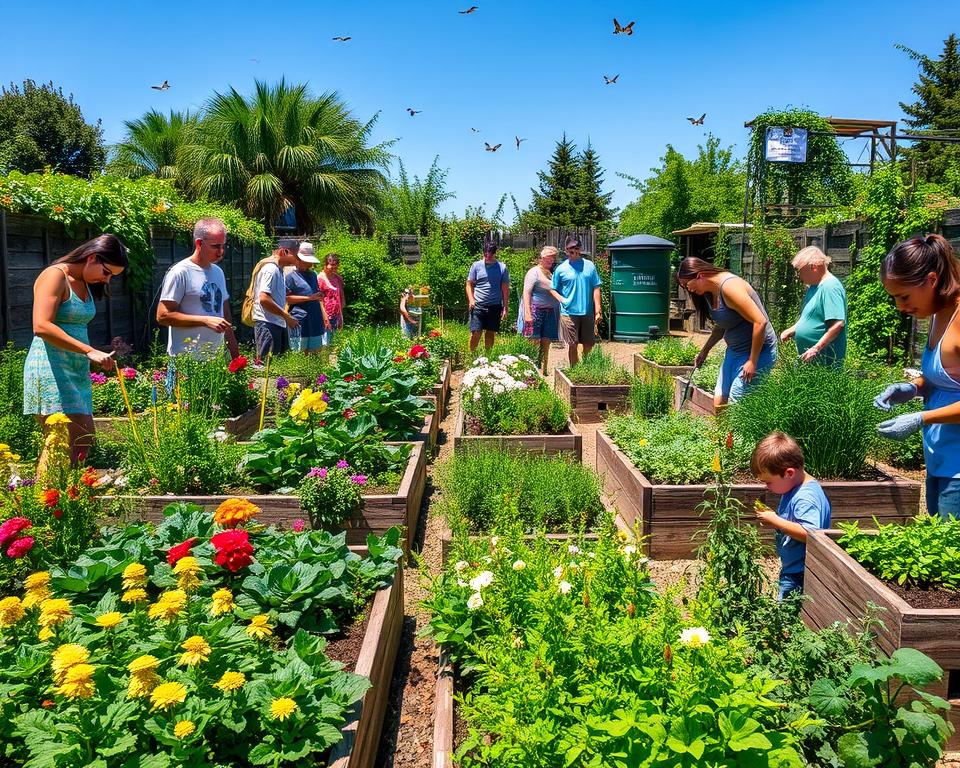Community garden initiatives are a powerful tool for making neighborhoods greener and more sustainable. New York State boasts around 3,000 officially recognized community gardens, with nearly 2,000 in New York City alone1. These spaces offer more than just a place to grow food; they foster community engagement and social interaction. They help residents eat more healthily, reducing the risk of diet-related health problems1. Programs like the NYC Parks Department’s GreenThumb initiative support these gardens, encouraging residents to participate in sustainable projects1.
Exploring community garden initiatives reveals the environmental and personal benefits of urban gardening. These gardens transform vacant lots into vibrant community spaces1. In the Bronx, for example, where nearly 35,000 people live per square mile and 30% of residents are below the poverty line, programs like Bronx Green-Up have made a significant difference1. Such initiatives are crucial for fostering a greener neighborhood and promoting sustainability through urban gardening and community projects.
Key Takeaways
- Community garden initiatives promote sustainability and community engagement
- Urban gardening programs provide opportunities for residents to get involved in sustainable community projects
- Community gardens offer a sustainable solution for repurposing vacant lots into usable community spaces1
- Community garden initiatives can positively impact the environment and residents’ lives
- Urban gardening programs, such as the NYC Parks Department’s GreenThumb program, support community gardens and provide opportunities for residents to get involved1
- Community gardens contribute to a more balanced diet among residents and reduce the risk of various health issues linked to poor nutrition1
What Are Community Garden Initiatives?
Community garden initiatives are collaborative efforts to create and maintain a shared green space. Here, people can grow their own food, socialize, and engage in community activities. These initiatives aim to promote sustainability, community engagement, and social interaction. They are crucial in local food movements, offering access to fresh produce and enhancing physical and mental health2.
Some of the key benefits of community garden initiatives include:
- Providing access to fresh produce, which can help reduce food insecurity concerns by up to 90% in impacted communities2.
- Promoting physical and mental health through activities such as gardening, social interaction, and increased access to green spaces2.
- Fostering a sense of community and social connection, which can help decrease feelings of isolation and boost self-esteem2.
Community garden initiatives also contribute to civic engagement in gardening. They enable residents to actively participate in maintaining their community gardens. For instance, Anchorage boasts 5 community gardens with 248 plots available for residents3. Friends of Portland Community Gardens also contributes over 30,000 pounds of fresh produce to local food banks annually3.
The History of Community Gardens in the U.S.
Community gardens in the United States trace their roots back to the early 20th century. These spaces were initially designed to offer urban dwellers a chance to cultivate their own food. They also served as a catalyst for community engagement. Over the years, organizations dedicated to gardening have been instrumental in preserving and expanding these green havens.
Historical documents reveal that community gardens were seen as a solution to urban blight since the 1890s4. In New York City, the 1970s saw the emergence of hundreds of community gardens due to the abandonment of buildings4. The Pennsylvania Horticultural Society (PHS) has also been a significant supporter, aiding nearly 180 community gardens, a number that has grown from 140 in just seven years5.
These gardens offer a range of benefits, from enhancing nutrition and reducing heart disease to fostering social bonds within communities4. Studies have shown that being near green spaces can decrease depression by nearly 70%5. Below is a table showcasing some key statistics about these gardens:
| City | Number of Community Gardens | Benefits |
|---|---|---|
| New York City | Over 400 | Improved nutrition, reduced heart disease |
| Philadelphia | Nearly 180 | Reduced feelings of depression, increased social cohesion |
In summary, community gardens have become a cornerstone in urban planning and sustainability efforts. They provide numerous advantages for both individuals and communities. By backing community gardening organizations and projects, we can foster more green spaces. This, in turn, promotes a healthier, more sustainable environment for all.
How to Start a Community Garden Initiative
Embarking on a community garden initiative demands meticulous planning and a thorough assessment of local interest. It’s crucial to measure the enthusiasm and backing from residents, community organizations, and key stakeholders6. This can be achieved through surveys, community gatherings, or focus groups to explore the concept of a community garden.
After confirming interest, identifying a prime location for the garden is the next imperative. This involves considering sunlight exposure, soil quality, and accessibility7. To initiate a community garden, one must gather seeds, tools, and financial backing. By adhering to these guidelines and fostering local engagement, a vibrant and enduring community garden can be established. Such a garden can be viewed as a form of grassroots gardening initiatives.
Community garden projects can profoundly influence the community. They can enhance access to fresh produce, improve gardening proficiency, and foster stronger community ties8. To participate in a community garden endeavor, visit the InfoTrendor website for insights into their garden projects and guidance on starting your own.
Key aspects to ponder when initiating a community garden project include:
- Evaluating community interest and support
- Locating an ideal site for the garden
- Acquiring vital resources, such as seeds, tools, and funding
- Engaging with the local community to foster a thriving and sustainable garden
By adhering to these steps and aligning with your community’s needs and aspirations, you can contribute to the establishment of a fruitful community garden initiative. This endeavor exemplifies the essence of community garden initiatives and grassroots gardening initiatives.
Successful Community Garden Examples
Community gardens are vital in urban gardening programs, offering numerous benefits to local communities. They play a key role in promoting social justice, community development, and environmental sustainability. For example, the New York State Department of Health and the Department of Agriculture and Markets have launched significant community garden initiatives over the past twenty years9.
The Beacon Food Forest in Seattle and Urban Harvest in Houston stand out as successful examples. The Beacon Food Forest transformed a vacant lot into a thriving food forest, highlighting the power of urban gardening in promoting sustainability and community engagement. Urban Harvest, on the other hand, has established over 150 community gardens in Houston, making fresh produce accessible and encouraging community involvement in sustainable projects.
In Portage, Indiana, and Charleston County, South Carolina, community gardens have also thrived, promoting urban gardening and sustainable projects9. These gardens offer fresh produce and serve as community hubs, fostering social connections and a sense of community. They also positively impact environmental sustainability, with initiatives like seed libraries and gardening tool kits being implemented in various cities10.
These examples showcase the potential of community gardens in promoting sustainable projects and urban gardening. They underscore the importance of community engagement and environmental sustainability in building thriving, resilient communities.
Community Garden Funding Options
Community gardening organizations and local food movements seek various funding sources to thrive. Grants from government agencies, foundations, and non-profits are a key source. For example, the Colorado Garden Foundation gives out over $13 million annually for gardening projects11. Whole Foods Market also offers a $3,000 grant for edible gardens at schools and non-profits11.
Other avenues include sponsorships from local businesses and crowdfunding. Crowdfunding allows people to contribute small amounts to support community gardens. The Urban Agriculture Resilience Program, for instance, grants between $5,000 and $20,00012. Organizations like the National Park Service’s Save America’s Treasures Grant Program have provided over $340 million since 200312.
Grants like the American Academy of Dermatology Shade Structure Grant offer up to $8,00012. The Herb Society of America grants provide up to $5,000 for herb-related educational projects12. By exploring these options, community gardens can secure the necessary funds to flourish.
Engaging Local Community Members
Engaging local community members is key to the success of community garden projects. By encouraging participation and offering volunteer roles, gardens can build a sense of community. This is done through events, workshops, and training sessions that teach gardening skills. Such initiatives are found in community garden programs focused on civic engagement and green spaces13.
Community gardening boosts civic pride and volunteerism, leading to better living standards and fewer problems14. It also fosters open communication and trust between local governments and residents. Community gardens offer chances for residents to participate, whether through volunteering or decision-making roles.
These gardens also foster social cohesion and collective responsibility. They provide a space for community members to collaborate, reducing social isolation and enhancing cooperation14. This is crucial in areas with low community engagement, helping to foster a sense of community and encourage civic involvement in gardening and green spaces.
Ways to encourage participation and volunteerism in community gardens include:
- Hosting events and workshops that promote gardening skills and knowledge
- Providing opportunities for community members to get involved in decision-making processes
- Offering volunteer opportunities that cater to different interests and skills
By engaging local community members and promoting volunteer opportunities, community gardens can foster a sense of community. This contributes to the success of garden initiatives and the development of green spaces13.
| Benefits of Community Engagement | Examples |
|---|---|
| Increased civic pride and volunteerism | Community garden events, workshops, and training sessions |
| Improved living standards and fewer complex problems | Community garden initiatives that promote social cohesion and collective responsibility |
Environmental Benefits of Community Gardens
Community gardens are crucial for urban biodiversity and soil quality, making them key to sustainable projects. They create green spaces in cities, offering habitats for wildlife and boosting biodiversity15. In areas with little greenery, they act as oases for both humans and animals.
They also improve soil quality through sustainable practices like composting and mulching. This reduces chemical use, promoting environmental sustainability16. It benefits the ecosystem and protects waterways from pollution.
Improving soil quality involves several steps:
- Using natural fertilizers, such as compost and manure
- Implementing conservation tillage to reduce soil erosion
- Planting cover crops to prevent erosion and promote soil health
These methods enhance soil structure, increase organic matter, and foster microbial activity. They are vital for sustainable gardening15.
Community gardens are vital for sustainable communities, offering environmental benefits like biodiversity and soil quality16. Supporting these initiatives helps create healthier, more sustainable places for all.
Educational Opportunities in Community Gardens
Community gardens serve as hubs for learning, offering workshops, classes, and school programs. These efforts are backed by community gardening organizations and local food movements. They aim to enhance community members’ knowledge and skills. For instance, Crestwood Elementary School in Las Vegas, where over 80% of students are Latinx, has seen a significant boost in morale thanks to its garden.
Students gain hands-on experience in sustainability, nutrition, and environmental science. The Bureau of Indian Education (BIE) schools across the nation incorporate school gardens into their curriculum. This approach aims to teach traditional Indigenous farming practices. Community gardens also offer a unique opportunity for individuals struggling with substance use disorders. They provide a nine-lesson nutrition education series focused on affordable meal preparation.
These educational opportunities are structured, including workshops on gardening, nutrition, and environmental science. There are also programs for schools, offering students hands-on learning experiences. This approach fosters a sense of community and social connection among participants.
Community gardens play a pivotal role in promoting knowledge and skills. They have a significant impact on the community, from enhancing student morale to aiding individuals with substance use disorders. As such, they are essential for fostering a connected and informed community.
| Community Garden Initiative | Location | Impact |
|---|---|---|
| Crestwood Elementary School Garden | Las Vegas | Improved student and school morale |
| BIE School Gardens | Nationwide | Instilled traditional Indigenous farming practices in students |
| Triumph Treatment Services Garden | Yakima County | Provided a nine-lesson nutrition education series |
Overcoming Challenges in Community Gardens
Community gardens, including grassroots gardening initiatives, often face significant hurdles. One major challenge is securing land access. This requires collaboration with local government, landowners, and stakeholders17. Managing conflicts among participants is another challenge. This can be mitigated by setting clear rules, encouraging open communication, and offering training and support18.
Strategies to overcome these challenges include:
* Building a strong sense of ownership among locals, which is crucial for a community garden’s success17
* Implementing sustainable practices like drip irrigation and rainwater harvesting to conserve water17
* Hosting workshops on sustainable gardening to engage the community and promote environmental stewardship17
* Involving local community members in gardening operations to enhance a sense of ownership and responsibility18
By tackling these challenges and adopting effective strategies, community garden initiatives can thrive. This not only benefits the environment but also the community at large19.
| Challenge | Strategy |
|---|---|
| Land access issues | Work with local government agencies, landowners, and stakeholders |
| Conflicts among participants | Establish clear rules and guidelines, promote communication and collaboration |
The Role of Technology in Community Gardening
Technology significantly impacts community gardening, making garden upkeep more efficient. Urban gardening initiatives benefit from web platforms for communication and coordination20. Apps for garden management also aid in tracking planting schedules and soil moisture, boosting gardening success by 40%20.
Sustainable community projects use technology to foster sustainability and lessen environmental harm. Smartphone apps offer gardening tips and reminders, while IoT technology enhances plant growth by monitoring conditions in real-time. This results in a 20-40% increase in crop yields20. Urban gardening also addresses food deserts, impacting 23.5 million people in the U.S20.
Key advantages of technology in community gardening include:
- Enhanced communication and coordination among garden members
- Improved garden management and maintenance efficiency
- Boosted plant growth and crop yields
- Greater access to fresh, organic produce
Technology aids urban gardening programs and sustainable projects in promoting sustainability and efficiency. It also enhances the gardening experience21. Technology, including web platforms and apps, plays a crucial role in community gardening22.
| Technology | Benefits |
|---|---|
| Web platforms | Improved communication and coordination |
| Apps for garden management | Increased efficiency and enhanced plant growth |
| IoT technology | Real-time monitoring and increased crop yields |
Future Trends in Community Garden Initiatives
Community garden initiatives are on the rise, with exciting trends shaping their future. A major focus is on sustainable practices to lessen environmental impact. This shift towards eco-friendliness is a cornerstone of urban gardening projects.
Sustainability Practices
Community gardens are now using rainwater harvesting, composting, and more to cut down on waste. These actions not only support green gardening but also teach the value of sustainable living. It’s a hands-on way to learn about caring for our planet.
Innovations in Urban Gardening
Community gardens are also diving into technology to boost food production in cities. Techniques like vertical gardening and hydroponics increase yields in tight spaces. Mobile apps help streamline operations and keep crops healthy23. These innovations show the potential for gardens to be more efficient and productive, supporting local food systems24.
By integrating sustainable practices and innovative gardening methods, community gardens are set to play a bigger role. They will promote environmental care, food security, and community ties. As these trends grow, the future of community gardening looks promising and full of potential.
FAQ
What are community garden initiatives?
What are the key benefits of community garden initiatives?
What is the history of community gardens in the U.S.?
How can one start a community garden initiative?
What are some successful community garden examples?
What are the funding options for community garden initiatives?
How can local community members engage with community garden initiatives?
What are the environmental benefits of community gardens?
What educational opportunities can community gardens provide?
What challenges do community garden initiatives face?
How can technology be used in community gardening?
What are the future trends in community garden initiatives?
Source Links
- The Power of Green: Community Gardens in Urban Planning • Public Works Partners
- ACSM Blog
- Community Gardens: How US Cities Are Putting Them To Work –
- Community Gardens – Museum of Reclaimed Urban Space
- From Seed to Community
- Sample Proposal on “Community Gardens for Food Security: Growing Together, Eating Well” – fundsforNGOs – Grants and Resources for Sustainability
- Joe Holzka Community Garden
- Community Garden Leader’s Tour: Fostering Connection, Sharing, and Place-Based Leadership
- Growing library garden programs
- Raleigh’s Community Gardens Initiative: Eastgate Garden Build — Inter-Faith Food Shuttle
- Garden Grants for Schools, Communities, and NonProfits
- Public Garden Funding Resources
- Partnering for Change: Growing Gardens’ Community Garden Initiatives
- What is Community Engagement: Examples & Models | GovOS
- The Benefits of Community Gardens — One New Humanity CDC
- How Community Gardens Grow Happier, Healthier People and Stronger Neighborhoods
- What strategies ensure the sustainability of a community garden?
- Cultivating Community, Resilience, and a Sustainable Future Through Urban Gardens
- Growing Together: Cultivating Health for Older Adults Through Community Gardens
- Urban Gardening: Transforming Cityscapes and Communities
- The Brutal Truth About Urban Gardening: Why It’s Not Just for Hipsters Anymore | EZ Flo Injection Systems
- Ohio State promotes STEM education with community garden
- Love, Your Garden: The Future of Connected Growing
- How does a community garden promote sustainable living practices?

Tony Allen is a writer at InfoTrendor, specializing in organic farming, permaculture, and sustainability. With a strong passion for regenerative agriculture and eco-friendly solutions, he explores topics such as sustainable food production, soil restoration, and innovative farming techniques. His goal is to empower readers with knowledge and practical insights to build a more sustainable and resilient future.



